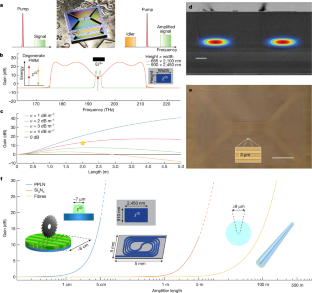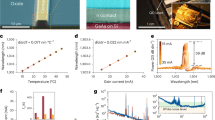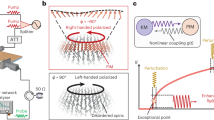Abstract
The ability to amplify optical signals is of pivotal importance across science and technology typically using rare-earth-doped fibres or gain media based on III–V semiconductors. A different physical process to amplify optical signals is to use the Kerr nonlinearity of optical fibres through parametric interactions1,2. Pioneering work demonstrated continuous-wave net-gain travelling-wave parametric amplification in fibres3, enabling, for example, phase-sensitive (that is, noiseless) amplification4, link span increase5, signal regeneration and nonlinear phase noise mitigation6. Despite great progress7,8,9,10,11,12,13,14,15, all photonic integrated circuit-based demonstrations of net parametric gain have necessitated pulsed lasers, limiting their practical use. Until now, only bulk micromachined periodically poled lithium niobate (PPLN) waveguide chips have achieved continuous-wave gain16,17, yet their integration with silicon-wafer-based photonic circuits has not been shown. Here we demonstrate a photonic-integrated-circuit-based travelling-wave optical parametric amplifier with net signal gain in the continuous-wave regime. Using ultralow-loss, dispersion-engineered, metre-long, Si3N4 photonic integrated circuits18 on a silicon chip of dimensions 5 × 5 mm2, we achieve a continuous parametric gain of 12 dB that exceeds both the on-chip optical propagation loss and fibre–chip–fibre coupling losses in the telecommunication C band. Our work demonstrates the potential of photonic-integrated-circuit-based parametric amplifiers that have lithographically controlled gain spectrum, compact footprint, resilience to optical feedback and quantum-limited performance, and can operate in the wavelength ranges from visible to mid-infrared and outside conventional rare-earth amplification bands.
This is a preview of subscription content, access via your institution
Access options
Access Nature and 54 other Nature Portfolio journals
Get Nature+, our best-value online-access subscription
$29.99 / 30 days
cancel any time
Subscribe to this journal
Receive 51 print issues and online access
$199.00 per year
only $3.90 per issue
Buy this article
- Purchase on Springer Link
- Instant access to full article PDF
Prices may be subject to local taxes which are calculated during checkout



Similar content being viewed by others
Data availability
The code and data used to produce the plots are found on the Zenodo repository https://doi.org/10.5281/zenodo.6989024.
References
Stolen, R. & Bjorkholm, J. Parametric amplification and frequency conversion in optical fibers. IEEE J. Quantum Electron. 18, 1062–1072 (1982).
Hansryd, J., Andrekson, P. A., Westlund, M., Li, J. & Hedekvist, P.-O. Fiber-based optical parametric amplifiers and their applications. IEEE J. Sel. Top. Quantum Electron. 8, 506–520 (2002).
Hansryd, J. & Andrekson, P. A. Broad-band continuous-wave-pumped fiber optical parametric amplifier with 49-dB gain and wavelength-conversion efficiency. IEEE Photonics Technol. Lett. 13, 194–196 (2001).
Tong, Z. et al. Towards ultrasensitive optical links enabled by low-noise phase-sensitive amplifiers. Nat. Photon. 5, 430–436 (2011).
Olsson, S. L., Eliasson, H., Astra, E., Karlsson, M. & Andrekson, P. A. Long-haul optical transmission link using low-noise phase-sensitive amplifiers. Nat. Commun. 9, 2513 (2018).
Olsson, S. L., Karlsson, M. & Andrekson, P. A. Nonlinear phase noise mitigation in phase-sensitive amplified transmission systems. Opt. Express 23, 11724–11740 (2015).
Foster, M. A. et al. Broad-band optical parametric gain on a silicon photonic chip. Nature 441, 960–963 (2006).
Lamont, M. R. et al. Net-gain from a parametric amplifier on a chalcogenide optical chip. Opt. Express 16, 20374–20381 (2008).
Kuyken, B. et al. 50 dB parametric on-chip gain in silicon photonic wires. Opt. Lett. 36, 4401–4403 (2011).
Morichetti, F. et al. Travelling-wave resonant four-wave mixing breaks the limits of cavity-enhanced all-optical wavelength conversion. Nat. Commun. 2, 296 (2011).
Wang, K.-Y. & Foster, A. C. GHz-rate optical parametric amplifier in hydrogenated amorphous silicon. J. Opt. 17, 094012 (2015).
Pu, M. et al. Ultra-efficient and broadband nonlinear AlGaAs-on-insulator chip for low-power optical signal processing. Laser Photonics Rev. 12, 1800111 (2018).
Ooi, K. et al. Pushing the limits of CMOS optical parametric amplifiers with USRN:Si7N3 above the two-photon absorption edge. Nat. Commun. 8, 13878 (2017).
Liu, X., Osgood, R. M., Vlasov, Y. A. & Green, W. M. Mid-infrared optical parametric amplifier using silicon nanophotonic waveguides. Nat. Photon. 4, 557–560 (2010).
Gajda, A. et al. Highly efficient CW parametric conversion at 1550 nm in SOI waveguides by reverse biased p-i-n junction. Opt. Express 20, 13100–13107 (2012).
Umeki, T., Tadanaga, O., Takada, A. & Asobe, M. Phase sensitive degenerate parametric amplification using directly-bonded PPLN ridge waveguides. Opt. Express 19, 6326–6332 (2011).
Kishimoto, T., Inafune, K., Ogawa, Y., Sasaki, H. & Murai, H. Highly efficient phase-sensitive parametric gain in periodically poled LiNbO3 ridge waveguide. Opt. Lett. 41, 1905–1908 (2016).
Liu, J. et al. High-yield, wafer-scale fabrication of ultralow-loss, dispersion-engineered silicon nitride photonic circuits. Nat. Commun. 12, 2236 (2021).
Mears, R. J., Reekie, L., Jauncey, I. M. & Payne, D. N. in Proc. Optical Fiber Communication Conference WI2 (Optical Society of America, 1987).
Desurvire, E., Simpson, J. R. & Becker, P. C. High-gain erbium-doped traveling-wave fiber amplifier. Opt. Lett. 12, 888–890 (1987).
Temprana, E. et al. Overcoming Kerr-induced capacity limit in optical fiber transmission. Science 348, 1445–1448 (2015).
Yamamoto, T. et al. Flux-driven Josephson parametric amplifier. Appl. Phys. Lett. 93, 042510 (2008).
Clerk, A. A., Devoret, M. H., Girvin, S. M., Marquardt, F. & Schoelkopf, R. J. Introduction to quantum noise, measurement, and amplification. Rev. Mod. Phys. 82, 1155–1208 (2010).
Macklin, C. et al. A near–quantum-limited Josephson traveling-wave parametric amplifier. Science 350, 307–310 (2015).
Devoret, M. H. & Schoelkopf, R. J. Superconducting circuits for quantum information: an outlook. Science 339, 1169–1174 (2013).
Marhic, M. E. et al. Fiber optical parametric amplifiers in optical communication systems. Laser Photonics Rev. 9, 50–74 (2015).
Marhic, M., Kagi, N., Chiang, T.-K. & Kazovsky, L. Broadband fiber optical parametric amplifiers. Opt. Lett. 21, 573–575 (1996).
Torounidis, T., Andrekson, P. A. & Olsson, B.-E. Fiber-optical parametric amplifier with 70-db gain. IEEE Photonics Technol. Lett. 18, 1194–1196 (2006).
Zhu, D. et al. Integrated photonics on thin-film lithium niobate. Adv. Opt. Photonics 13, 242–352 (2021).
Ledezma, L. et al. Intense optical parametric amplification in dispersion-engineered nanophotonic lithium niobate waveguides. Optica 9, 303–308 (2022).
Xuan, Y. et al. High-Q silicon nitride microresonators exhibiting low-power frequency comb initiation. Optica 3, 1171–1180 (2016).
Ye, Z., Twayana, K., Andrekson, P. A. & Torres-Company, V. High-Q Si3N4 microresonators based on a subtractive processing for Kerr nonlinear optics. Opt. Express 27, 35719–35727 (2019).
Chang, L. et al. Ultra-efficient frequency comb generation in AlGaAs-on-insulator microresonators. Nat. Commun. 11, 1331 (2020).
Wilson, D. J. et al. Integrated gallium phosphide nonlinear photonics. Nat. Photon. 14, 57–62 (2020).
Jung, H. et al. Tantala Kerr nonlinear integrated photonics. Optica 8, 811–817 (2021).
Kim, D.-G. et al. Universal light-guiding geometry for on-chip resonators having extremely high Q-factor. Nat. Commun. 11, 5933 (2020).
Levy, J. S. et al. CMOS-compatible multiple-wavelength oscillator for on-chip optical interconnects. Nat. Photon. 4, 37–40 (2010).
Moss, D. J., Morandotti, R., Gaeta, A. L. & Lipson, M. New CMOS-compatible platforms based on silicon nitride and Hydex for nonlinear optics. Nat. Photon. 7, 597–607 (2013).
Gyger, F. et al. Observation of stimulated Brillouin scattering in silicon nitride integrated waveguides. Phys. Rev. Lett. 124, 013902 (2020).
Okawachi, Y. et al. Octave-spanning frequency comb generation in a silicon nitride chip. Opt. Lett. 36, 3398–3400 (2011).
Kippenberg, T. J., Gaeta, A. L., Lipson, M. & Gorodetsky, M. L. Dissipative Kerr solitons in optical microresonators. Science 361, eaan8083 (2018).
Turner, A. C. et al. Tailored anomalous group-velocity dispersion in silicon channel waveguides. Opt. Express 14, 4357–4362 (2006).
Blows, J. L. & French, S. E. Low-noise-figure optical parametric amplifier with a continuous-wave frequency-modulated pump. Opt. Lett. 27, 491–493 (2002).
Mussot, A. et al. Impact of pump phase modulation on the gain of fiber optical parametric amplifier. IEEE Photonics Technol. Lett. 16, 1289–1291 (2004).
Ikeda, K., Saperstein, R. E., Alic, N. & Fainman, Y. Thermal and Kerr nonlinear properties of plasma-deposited silicon nitride/silicon dioxide waveguides. Opt. Express 16, 12987–12994 (2008).
Gao, M. et al. Probing material absorption and optical nonlinearity of integrated photonic materials. Nat. Commun. 13, 3323 (2022).
Karlsson, M. Four-wave mixing in fibers with randomly varying zero-dispersion wavelength. J. Opt. Soc. Am. B 15, 2269–2275 (1998).
Torres-Company, V., Ye, Z., Zhao, P., Karlsson, M. & Andrekson, P. A. in 2022 Optical Fiber Communications Conference and Exhibition (OFC) (IEEE, 2022).
Ye, Z. et al. Overcoming the quantum limit of optical amplification in monolithic waveguides. Science Adv. 7, eabi8150 (2021).
Del’Haye, P., Arcizet, O., Gorodetsky, M. L., Holzwarth, R. & Kippenberg, T. J. Frequency comb assisted diode laser spectroscopy for measurement of microcavity dispersion. Nat. Photon. 3, 529–533 (2009).
Liu, J. et al. Frequency-comb-assisted broadband precision spectroscopy with cascaded diode lasers. Opt. Lett. 41, 3134–3137 (2016).
He, J. et al. Low-loss integrated nanophotonic circuits with layered semiconductor materials. Nano Lett. 21, 2709–2718 (2021).
Soller, B. J., Gifford, D. K., Wolfe, M. S. & Froggatt, M. E. High resolution optical frequency domain reflectometry for characterization of components and assemblies. Opt. Express 13, 666–674 (2005).
Pu, M., Ottaviano, L., Semenova, E. & Yvind, K. Efficient frequency comb generation in AlGaAs-on-insulator. Optica 3, 823–826 (2016).
Wilson, D. J. et al. Integrated gallium phosphide nonlinear photonics. Nat. Photon. 14, 57–62 (2020).
Gondarenko, A., Levy, J. S. & Lipson, M. High confinement micron-scale silicon nitride high Q ring resonator. Opt. Express 17, 11366–11370 (2009).
Levy, J. Integrated Nonlinear Optics In Silicon Nitride Waveguides and Resonators. PhD thesis, Cornell Univ. (2011).
Acknowledgements
We thank T. Liu for assisting in the waveguide spiral design and M. H. Anderson for the discussion. The Si3N4 chips were fabricated in the EPFL Center of MicroNanoTechnology (CMi). This work was supported by the Air Force Office of Scientific Research (AFOSR) under award no. FA9550-19-1-0250, by contract HR0011-20-2-0046 (NOVEL) from the Defense Advanced Research Projects Agency (DARPA), Microsystems Technology Office (MTO) and by the Swiss National Science Foundation (SNSF) under grant agreement no. 192293. J.R. acknowledges support from the SNSF under an Ambizione Fellowship (201923).
Author information
Authors and Affiliations
Contributions
J.L. and R.N.W. designed and fabricated the samples. J.R., N.K. and J.H. performed the experiments and data analysis. J.R. performed the numerical simulations. J.R., J.L. and T.J.K. wrote the manuscript. T.J.K. supervised the project.
Corresponding authors
Ethics declarations
Competing interests
T.J.K. is a cofounder and shareholder of LiGenTec SA, a company that is engaged in making Si3N4 nonlinear photonic chips available through foundry service.
Peer review
Peer review information
Nature thanks Dawn T. H. Tan and the other, anonymous, reviewer(s) for their contribution to the peer review of this work. Peer reviewer reports are available.
Additional information
Publisher’s note Springer Nature remains neutral with regard to jurisdictional claims in published maps and institutional affiliations.
Extended data figures and tables
Extended Data Fig. 1 Numerical calculations of maximum (small) signal gain as a function of waveguide loss and length.
a, For a waveguide of cross section dimensions 2,450 nm × 910 nm and pump power of 4 W, as used in this study. The dotted grey lines represent the threshold for on-chip parametric gain. b, For optimized waveguide cross section of 2,100 nm × 670 nm using 0.75 W of pump power. The lowest waveguide loss value of 0.15 dB m−1 represents the waveguide absorption loss of Si3N4 structures fabricated using the photonic Damascene process at EPFL.
Extended Data Fig. 2 Frequency-comb-calibrated characterization of waveguide spirals.
a, Optical setup. See text for description. b, Calibrated transmission spectrum through a spiral. The trace colours indicate the three individual external-cavity diode laser scans. c, Calibrated reflection spectrum inside and from a spiral. d, OFDR traces are analysed using segmented Fourier transformation and vertically offset by 15 dB. The shading indicates the centre frequency according to panel e. The propagation loss fitting region is marked with vertical orange lines. The propagation loss is determined from the dotted line fit. e, Propagation loss extracted from OFDR. Extracted propagation losses are relative to optical distance and must be multiplied by the group index of 2.08 for conversion to the physical waveguide length. The values represent upper bounds owing to a background of laser phase noise that induces an increased gradient. f,g, Zooming into OFDR traces around the front (f) and back (g) facets. Dots depict successful identification of backside facet reflection for valid dispersion measurement. h, Inverse group velocity β1 as a function of wavelength. Markers correspond to f,g. The black line indicates the fitted waveguide dispersion curve up to the third order.
Extended Data Fig. 3 Mode mixing and interference in rectangular waveguide spirals.
a, Schematic indication of a typical 90° waveguide bend in a rectangular spiral. All bends are identical and have a radius of 230 μm. Insets show the normalized mode profile for the TE00, TE10 and TE20 modes. b, Simulated group refractive indices for the TE00, TE10 and TE20 modes of a 2.45 μm × 0.91 μm strip waveguide with vertical sidewalls. c, Calculated spectral frequencies for destructive interference between higher-order mode excitation at the beginning and at the end of the waveguide bend.
Extended Data Fig. 4 Raw data of gain spectrum measurement.
See the main text for detailed description.
Supplementary information
Rights and permissions
Springer Nature or its licensor (e.g. a society or other partner) holds exclusive rights to this article under a publishing agreement with the author(s) or other rightsholder(s); author self-archiving of the accepted manuscript version of this article is solely governed by the terms of such publishing agreement and applicable law.
About this article
Cite this article
Riemensberger, J., Kuznetsov, N., Liu, J. et al. A photonic integrated continuous-travelling-wave parametric amplifier. Nature 612, 56–61 (2022). https://doi.org/10.1038/s41586-022-05329-1
Received:
Accepted:
Published:
Issue Date:
DOI: https://doi.org/10.1038/s41586-022-05329-1
This article is cited by
-
Parity-time symmetry enabled ultra-efficient nonlinear optical signal processing
eLight (2024)
-
Large second-order susceptibility from a quantized indium tin oxide monolayer
Nature Nanotechnology (2024)
-
A wideband, high-resolution vector spectrum analyzer for integrated photonics
Light: Science & Applications (2024)
-
High density lithium niobate photonic integrated circuits
Nature Communications (2023)
-
All-dielectric scale invariant waveguide
Nature Communications (2023)
Comments
By submitting a comment you agree to abide by our Terms and Community Guidelines. If you find something abusive or that does not comply with our terms or guidelines please flag it as inappropriate.



